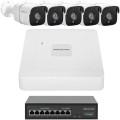Recorder
This parameter refers to the included DVR and describes the types of video signal (and therefore cameras) with which it is compatible. In some cases, the model is also indicated - for connoisseurs of the matter. So you can learn more about the capabilities of the device on specialized sources.
-
Analog. Recorders capable of working only with analog cameras, usually connected via the BNC interface (see below). The functionality of such devices is less extensive than in digital and hybrid models, but they are simple, inexpensive and quite capable of coping with basic video surveillance tasks. We also note that a modern analog recorder usually has video outputs and service interfaces in a digital format - primarily HDMI and LAN (see below).
-
Digital. Recorders designed to work with IP cameras - that is, cameras that transmit video signal through computer networks. This signal format provides improved noise immunity and a greater number of additional features compared to analog. In addition, it allows you to build video surveillance systems based on existing local networks, and cameras can be connected not only by wire, but also wirelessly (see below for more details). On the other hand, digital recorders and cameras are more expensive than analog ones, advanced functionality is not often needed in practice, and the transfer of a large number of video streams can create a high load on net
...work equipment. Therefore, it makes sense to purchase such a recorder only if the described advantages have crucial.
- Hybrid. Recorders that combine the capabilities of analog and digital models - that is, compatible with both analog and IP cameras. This combination allows you to combine the advantages of both types and partly compensate for the shortcomings, but significantly increases the price of the registrar.Video channels
The number of video channels that the set's recorder is capable of simultaneously processing. In fact, this is the number of cameras that the device can simultaneously work with; it is technically possible to connect more cameras, but this will require additional equipment — such as quadrators.
The choice for this parameter depends on how extensive and extensive the observation system is planned to be built. At the same time, it should be noted that modern technologies allow combining several registrars into a system with a single control; therefore, for numerous cameras, it is sometimes easier to purchase several relatively modest kits than one multi-channel one.
Number of drives spaces
The number of "seats" for built-in drives, provided in the design of the registrar. The vast majority of modern registrars are designed for one drive — this is quite enough for their main purpose.
Note that the form factor of supported drives can be different, this point should be clarified separately.
Max. capacity
The largest storage capacity with which the recorder is able to work normally.
The more capacious the drive, the higher the processing power of the system in which it is used should be. Therefore, any modern registrar has limitations on disk capacity. However, even in the most modest models, this figure is about 2 TB, in most cases this is quite enough to work with the capabilities provided in this particular registrar.
HDD included
The presence of
a hard drive in the kit, on the one hand, allows you to use the kit right out of the box, on the other hand, it increases the cost, which, given the existing drive, makes purchasing such a model inappropriate. Therefore, you can often find models both with an HDD in the kit, and "clean devices" with the need to independently purchase a hard drive. The second option is even more relevant in most cases, since a drive of a certain capacity is selected for various needs and the customer himself has the right to choose the volume, manufacturer and other parameters of the HDD.
Pointed cameras
The number of pointed cameras that are standardly supplied with the video surveillance kit. For more information about this variety, see "Type of cameras", here we note that the total number of cameras in the set (both pointed and dome cameras), usually, is less than the number of video channels (see above). This allows you to buy additional cameras if necessary, choosing them at your discretion.
Camera model
A model of pointed cameras supplied with a video surveillance kit. Knowing this data, you can find detailed information on the cameras and clarify their characteristics. Also, if you buy additional cameras of the same model, you don't have to worry about compatibility.
Matrix size
The physical size of the sensor in the pointed cameras is diagonally, in inches (fractions of an inch).
The larger the sensor, the less prone it is to noise, the better image quality it can provide, and the better it is suited to low light conditions. This is due to the fact that each individual pixel gets more light, because. on a large matrix and individual dots are larger. On the other hand, large matrices are more expensive.
Number of megapixels
Sensor resolution of pointed cameras in megapixels (millions of pixels).
Higher resolution allows you to get a more detailed "picture". However, increasing the number of megapixels without increasing the sensor size can result in poor overall image quality and noise, especially in low light. Therefore, in itself, the high resolution of the matrix does not guarantee high quality shooting.

